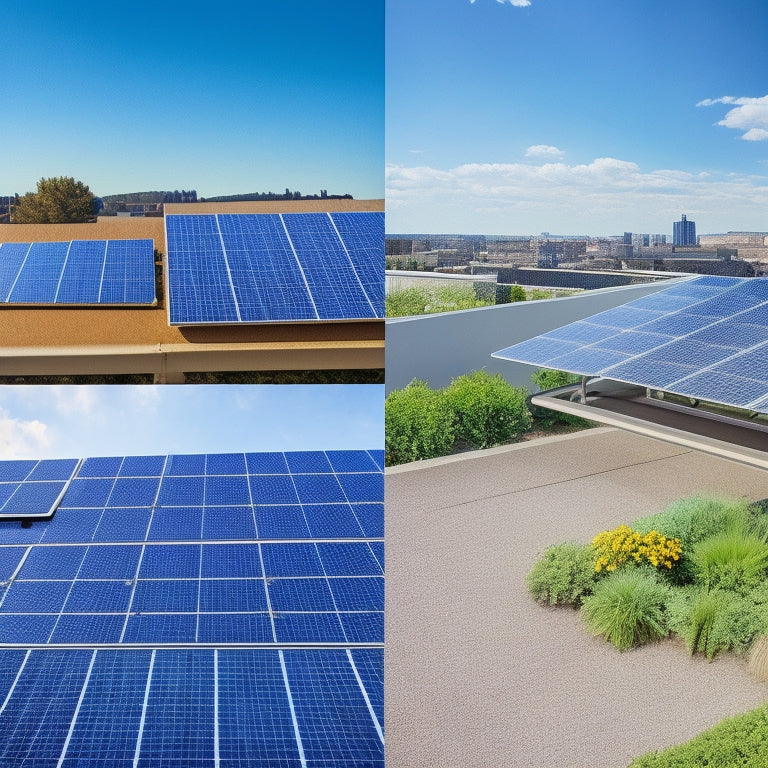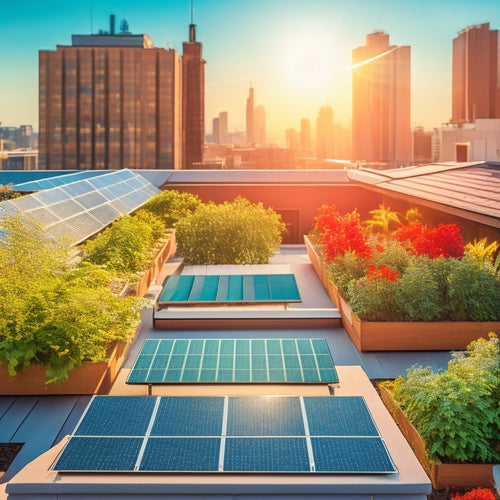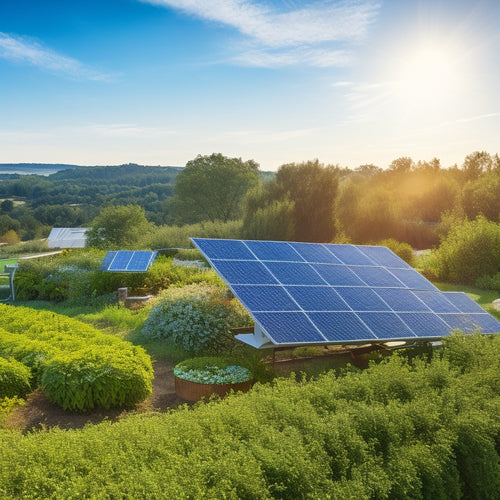
Why Commercial Solar Panel Installation Prices Vary
Share
Your commercial solar panel installation prices vary widely depending on a combination of key factors. You'll need to take into account system size and complexity, as well as the type and quality of equipment. The installation company's experience level also plays a significant role, as does the size and shape of your roof. Local building codes, permits, and labor costs all impact the final price tag. Additionally, mounting and tracking system costs, inverter and monitoring system prices, and battery backup system options contribute to the overall cost. Understanding these factors is essential for getting an accurate quote, and there's more to explore when it comes to optimizing your solar panel installation.
Key Takeaways
• Commercial solar panel installation prices vary due to differences in system size and complexity, affecting design and energy requirements.
• The type and quality of equipment, including module efficiency and inverter technology, impact performance, reliability, and cost.
• Installation company experience level and expertise influence prices, with more experienced companies commanding higher prices.
• Regional factors, including labor and material costs, local building codes, and permits, contribute to price variations.
• Energy efficiency and certification standards, such as those for mounting and tracking systems, inverters, and monitoring systems, also impact installation prices.
System Size and Complexity Matters
When sizing up a commercial solar panel installation, you're not just looking at the number of panels, but also the complexity of the system, which greatly impacts the overall installation price.
The system's complexity is influenced by design constraints, such as the available roof space, local building codes, and environmental factors. Your energy requirements also play a significant role, as they dictate the system's power density and scalability.
To accurately determine the required system size, you need to conduct load calculations, taking into account the electrical infrastructure of the building. This includes evaluating the existing electrical infrastructure, including the capacity of the electrical panels and the type of electrical service.
A more complex system requires more sophisticated design and installation, resulting in higher costs. Hence, it's crucial to carefully evaluate your energy needs and the system's complexity to ensure a cost-effective installation that meets your commercial solar panel needs.
Type and Quality of Equipment
When it comes to commercial solar panel installation prices, the type and quality of equipment play a significant role. You'll need to take into account the module efficiency ratings, which can range from 15% to over 22%, and how they impact your system's overall performance.
Additionally, you'll have to decide on inverter technology options, such as string inverters or power optimizers, which can affect the system's reliability and maintenance requirements.
Module Efficiency Ratings
You'll want to prioritize high-efficiency solar panels, as they can greatly impact the overall performance of your commercial solar panel installation. Module efficiency ratings play an important role in determining the quality of your solar panels. A higher efficiency rating means more electricity is generated per unit area, resulting in a more effective system.
Here's a comparison of different module efficiency ratings:
| Efficiency Rating | Characteristics |
|---|---|
| Low (15-17%) | Lower cost, higher temperature coefficient, lower panel durability |
| Mid-range (18-20%) | Balanced cost and efficiency, moderate temperature coefficient, average panel durability |
| High (21-23%) | Higher cost, lower temperature coefficient, higher panel durability |
| Premium (24%+) | Highest cost, lowest temperature coefficient, highest panel durability |
When selecting solar panels, consider the trade-off between cost and efficiency. Higher efficiency ratings often come at a higher cost, but they can provide more electricity per unit area and better performance in high-temperature conditions. Additionally, higher-efficiency panels tend to have better panel durability, reducing the risk of degradation over time. By prioritizing high-efficiency solar panels, you can ensure excellent performance and a stronger return on investment for your commercial solar panel installation.
Inverter Technology Options
Your commercial solar panel installation's inverter technology plays an essential role in converting DC power from the solar panels to AC power for your business, and selecting the right type and quality of equipment is crucial for peak performance and reliability.
You'll need to contemplate the inverter technology options, including Micro Inverters, Power Optimizers, and String Inverters.
Micro Inverters, for instance, are installed under each solar panel, providing maximum power point tracking (MPPT) at the panel level. This setup offers greater flexibility, easier installation, and improved monitoring capabilities.
On the other hand, Power Optimizers are installed at the panel level as well, but they're paired with a central inverter. This hybrid approach offers a balance between cost and performance.
The type and quality of inverter technology you choose will have a significant impact on your system's overall efficiency, reliability, and cost. By understanding the pros and cons of each option, you can make an informed decision that meets your business's unique energy needs and budget constraints.
Installation Company Experience Level
The experience level of the installation company greatly influences the overall cost of commercial solar panel installation. More seasoned companies typically command higher prices due to their established reputation and quality of work.
When you're considering a commercial solar panel installation, you'll want to look into the company's history and team expertise. A company with a long history of successful installations will likely charge more than a newer company with less experience. This is because they've developed a reputation for quality work and have refined their processes over time.
You'll benefit from their team's expertise, which can include specialized knowledge of local building codes, permits, and inspections. Additionally, experienced companies often have established relationships with suppliers, which can result in better pricing for equipment.
While a higher price tag may seem challenging, you'll be paying for the assurance that your installation will be done correctly and efficiently.
Roof Size and Shape Factors
When calculating commercial solar panel installation prices, you'll need to take into account the roof size and shape factors that affect the installation process.
Complex roof geometries, such as those with multiple skylights or vents, can increase installation costs. Additionally, obstructed roof areas, like those with existing HVAC systems or equipment, can also impact the final price tag.
Complex Roof Geometry
Moreover, it's crucial to understand how complex roof geometries impact pricing. Complex roof geometries, characterized by irregular shapes, numerous skylights, or multiple levels, increase installation costs by 10% to 20% due to the additional time and labor required to navigate these obstacles.
These complex geometries affect the installation process in several ways. Angular shading, for instance, can reduce the system's energy output, requiring more panels to meet your energy goals. You'll need more panels to compensate for the energy lost due to shading, increasing the overall cost. Obstructed ventilation is another concern, as it can lead to overheating and reduced system performance.
To mitigate these issues, installers may need to use specialized equipment or modify their installation techniques, adding to the overall cost. Additionally, complex roof geometries can also increase the risk of installation errors, which can lead to costly rework or even system failure.
Obstructed Roof Areas
You'll likely encounter obstructed roof areas, where vents, skylights, or other obstacles reduce the usable space for your commercial solar panel installation, impacting the system's overall performance and cost. These obstructions can lead to shading issues, which can have a notable impact on the system's energy output.
A thorough shading analysis is crucial to identify areas with partial or complete shading, guaranteeing that your solar panel installation is optimized for maximum energy production.
To overcome these challenges, solar installers may need to implement customized solutions, such as raised racking systems or specialized mounting hardware, to ensure adequate roof clearance and minimize shading effects. This may increase the installation cost, but it's vital to secure the system's long-term performance and reliability.
Local Building Codes and Permits
Prior to starting a commercial solar panel installation, it's important to familiarize yourself with local building codes and obtain necessary permits to avoid costly delays or even project cancellation. You must understand that local building codes and permits can greatly impact your installation costs.
Here are three key considerations to keep in mind:
-
Zoning regulations: Make sure that your commercial solar panel installation complies with local zoning regulations, including setbacks, height restrictions, and property line requirements.
-
Permitting timelines: Plan ahead and factor in permitting timelines, which can vary greatly depending on the municipality and complexity of the project.
-
Code compliance and inspection processes: Ensure that your installation meets local building codes and is inspected according to the municipality's inspection processes, which may include multiple inspections and approvals.
Failure to comply with local building codes and permits can lead to costly rework, fines, or even project cancellation. Additionally, you'll need to factor in municipality fees, which can add up quickly.
Energy Efficiency and Certifications
When evaluating commercial solar panel installation prices, you should consider the energy efficiency and certifications of the system.
You'll want to verify that the system's components meet high-quality standards, that the certifier has a reputable reputation, and that the installation complies with efficiency standards.
System Component Quality
High-quality system components, certified by reputable organizations and boasting impressive energy efficiencies, can greatly impact the overall performance and cost-effectiveness of your commercial solar panel installation.
When evaluating system component quality, consider the following key factors:
-
Brand reputation: A reputable brand is more likely to provide high-quality components that stand the test of time. Look for brands with a proven track record of producing efficient and durable components.
-
Material durability: The durability of system components, such as panels and inverters, can have a substantial impact on their performance over time. Look for components made with high-quality materials that can withstand various environmental conditions.
-
Certifications and standards: Guarantee that system components meet or exceed industry standards and certifications, such as UL (Underwriters Laboratories) or IEC (International Electrotechnical Commission) certifications. These certifications attest that components meet specific safety and performance standards.
Certifier Reputation Matters
As you evaluate the certifications and standards of your commercial solar panel installation, you'll find that the reputation of the certifier itself plays a significant role in guaranteeing the energy efficiency and reliability of your system.
A reputable certifier guarantees that the installation meets industry standards, adhering to a rigorous certification process that involves auditor independence. This independence guarantees unbiased assessments, ensuring that your system meets the required standards.
When evaluating a certifier's reputation, consider their reputation metrics, such as their experience, expertise, and compliance history. A certifier with a strong reputation will have a proven track record of adhering to industry standards and regulations.
This reduces the risk of non-compliance, guaranteeing that your system operates efficiently and effectively. By selecting a reputable certifier, you can have confidence in the performance and reliability of your commercial solar panel installation, ultimately impacting the overall cost of the system.
Efficiency Standards Compliance
Your commercial solar panel installation must meet efficiency standards to guarantee peak energy production and minimize costs, and certifications play an important role in verifying that compliance. In the solar industry, efficiency standards are essential to make sure that your system operates at its best. Regulatory frameworks, such as those set by the International Electrotechnical Commission (IEC), provide guidelines for manufacturers and installers to follow.
To make sure your system meets these standards, you should look for certifications like UL (Underwriters Laboratories) or IEC marks. These certifications indicate that your system has been tested and meets the required efficiency standards.
Here are three key benefits of efficiency standards compliance:
-
Maximized Energy Production: Meeting efficiency standards ensures your system produces the maximum amount of energy possible, reducing your reliance on the grid and increasing your savings.
-
Compliance Incentives: Governments often offer incentives, such as tax credits or rebates, to businesses that install energy-efficient systems, which can help offset the initial cost of installation.
-
Reduced Maintenance: Efficient systems require less maintenance, reducing the likelihood of component failures and extending the lifespan of your system.
Mounting and Tracking System Costs
You'll need to budget around 10-15% of your total solar panel installation cost for a mounting and tracking system, which can range from $1,500 to $3,000 or more for a typical residential setup.
This may seem like a significant expense, but a high-quality mounting and tracking system is essential for guaranteeing the structural integrity of your solar panel array. A well-designed system will provide adequate ground clearance to prevent water accumulation and reduce the risk of corrosion.
Additionally, a tracking system will optimize energy production by adjusting the panel angle to maximize sunlight exposure. When selecting a mounting and tracking system, consider factors such as durability, adjustability, and wind load capacity. Be wary of cheap alternatives that may compromise your system's performance and longevity.
Inverter and Monitoring System Prices
As you consider commercial solar panel installation, it's important to understand the cost factors involved. The inverter, responsible for converting DC power to usable AC, and the monitoring system, which tracks performance and detects issues, together account for around 10-15% of the total solar panel installation cost, with prices ranging from $2,000 to $5,000 or more, depending on the size and complexity of the system.
Here are three key aspects affecting inverter and monitoring system prices:
-
Inverter type: String inverters, central inverters, and microinverters have different price points, with string inverters being the most cost-effective option.
-
Monitoring system features: Advanced data analytics and real-time monitoring capabilities increase the cost of the monitoring system, but provide valuable insights to optimize system performance and achieve Grid Parity.
-
System size and complexity: Larger systems with multiple inverters and monitoring systems require more complex installations, driving up costs.
As you evaluate commercial solar panel installation options, understanding the inverter and monitoring system costs is vital to achieving a cost-effective and efficient system. By considering these factors, you can optimize your system design and achieve a faster return on investment.
Battery Backup System Options
Commercial solar panel installations can greatly benefit from integrating battery backup systems, which store excess energy generated during the day for use during periods of low sunlight or at night, guaranteeing a stable and reliable power supply.
As you consider battery backup system options, you'll want to assess your energy autonomy goals. Do you want to reduce your reliance on the grid or achieve complete energy independence? Your answer will impact the type and size of battery system you need.
For instance, if you prioritize grid reliability, you might opt for a smaller battery system that provides backup power during outages. On the other hand, if you aim for energy autonomy, you'll likely require a larger system that can store more energy.
When selecting a battery backup system, consider factors like depth of discharge, round-trip efficiency, and warranty duration. You should also evaluate the compatibility of the battery system with your existing solar panel installation and inverter technology.
Regional Labor and Material Costs
Depending on your location, regional labor and material costs notably impact the overall expense of your commercial solar panel installation. Prices can vary by as much as 20% to 30% across different regions.
As you navigate the installation process, it's crucial to take into account the regional factors that influence your bottom line.
Here are three key factors that contribute to regional labor and material costs:
-
Union wages: In regions with strong labor unions, you may incur higher labor costs due to mandated union wages.
-
Local tariffs and taxes: Regional taxes, tariffs, and fees can significantly influence the cost of materials and equipment. Be sure to research local regulations and incentives that may impact your installation costs.
-
Supply chain logistics: The cost of transporting materials and equipment to your site can vary greatly depending on your location. Remote or hard-to-reach areas may incur higher logistics costs.
Moreover, regional tax incentives can also impact your installation costs. Some regions offer attractive incentives, such as tax credits or rebates, to encourage the adoption of solar energy.
Understanding these regional factors will help you better anticipate and manage your installation costs.
Frequently Asked Questions
Can I Install Solar Panels Myself to Save Money?
You can attempt a DIY solar panel installation, but be aware that you'll assume all DIY safety risks and must make sure your roof condition can support the added weight and structural stress.
Do Solar Panels Work During Power Outages?
You're wondering if solar panels work during power outages. They don't, unless you have energy storage, like batteries, which provide grid resilience. In this case, your solar panels can keep generating power, even when the grid is down.
Can I Finance My Solar Panel Installation?
You can finance your solar panel installation through solar loans, which offer flexible repayment terms, and take advantage of financial incentives like tax credits and rebates to offset the upfront cost.
How Long Does It Take to Install Solar Panels?
You'll typically spend 3-5 days on a standard commercial solar panel installation, depending on your panel design complexity, with a detailed installation timeline outlining each stage, from site preparation to final inspection and energization.
Are Solar Panels Environmentally Friendly?
As you harness the power of the sun, you'll find that solar panels are indeed environmentally friendly, boasting a minimal eco footprint and generating clean, green energy that reduces your reliance on fossil fuels.
Related Posts
-

Solar System Installation Rebates and Tax Credits
Solar system installations offer beneficial rebates and tax credits that greatly cut your initial costs. You can bene...
-

Solar Inverter Troubleshooting for Beginners
Troubleshooting your solar inverter starts with understanding its efficiency and performance metrics. Check for prope...
-

Green Energy Alternatives for Independent Living
To enhance your independent living, consider green energy alternatives like solar panels and wind turbines. These opt...


